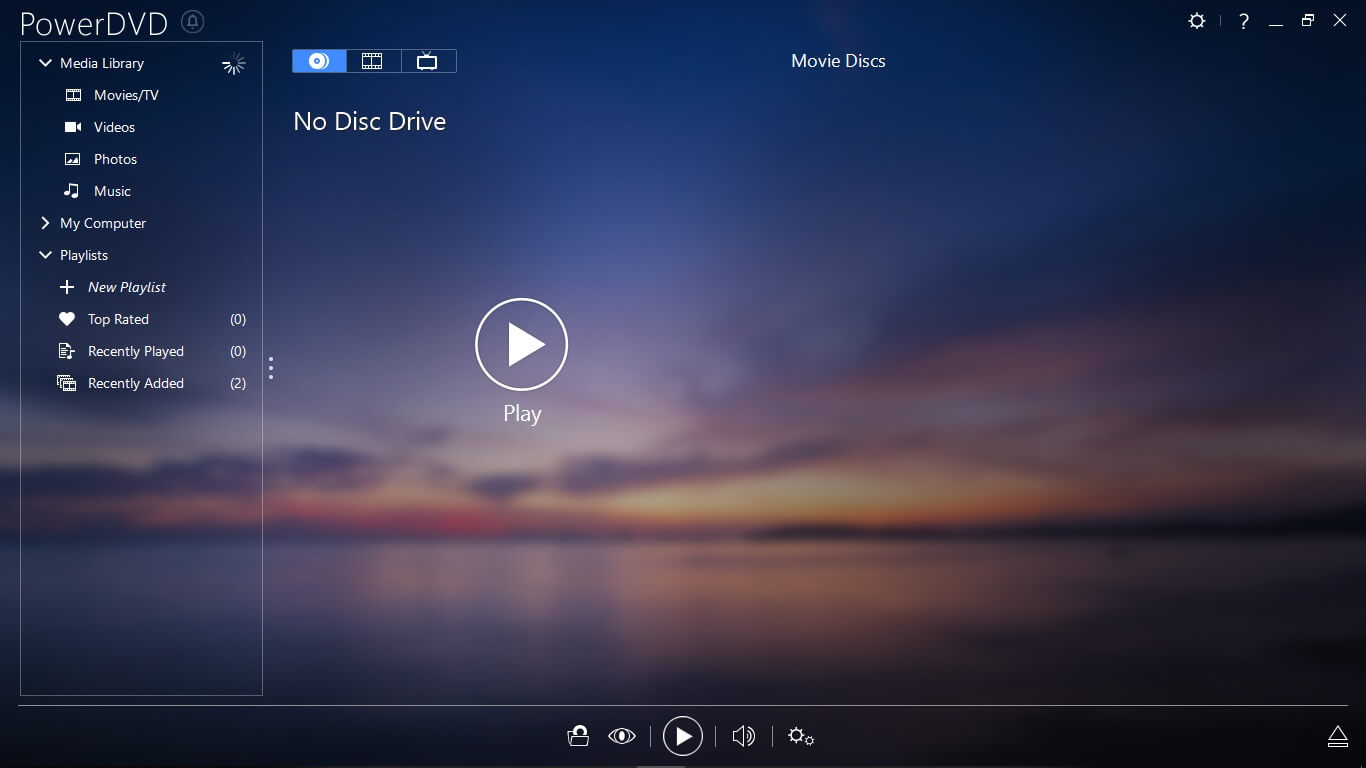Restore the Player from mini Player mode. Zoom to 50 percent. Show the Tools menu. Zoom to 100 percent. Show the View menu. Zoom to 200 percent. Go to the Features taskbar features. Show or hide album information in the Rip feature. Move left or right or up or down on menus.
- Windows Media Player 12+ version was missing the one of the best features of older Windows Media Players (WMP) and that was the mini-player that appeared when you minimized it. The WMP Mini-Player allows you to access the media player right from the Taskbar or system tray area.
- CnX Player - 4K HEVC player is the best media player available for free on Windows 10 that supports tablet mode also. Some key highlights of CnX Player: Very cool intuitive user interface with multiple gesture controls Mini player aka floating windows view with Awesome video quality.




And here’s a list of features Microsoft shamelessly eliminated in Windows Media Player 11 and 12:
Windows Media Player 11
● Album art is restricted to a resolution of 200 x 200 in version 11 or to 240 x 240 in version 12.
● The List Pane no longer allows deleting or editing items by right clicking items.
● Categories in the player library such as Music, Pictures, Videos, Recorded TV show limited media information (metadata) columns, relevant only to their content type. In previous versions, all possible metadata columns were shown for all category types.
● Buttons to always show full-screen controls, show or hide the playlist while in full-screen mode and directly close Windows Media Player from full-screen have been removed.
● Auto sorting in the media library (similar to auto sorting in Windows Explorer) cannot be turned off.
● Grouping cannot be turned off. Library content is always grouped by the criteria by which it is sorted.
● The ability to add media to the library for searching local or network files and selectively adding only new files or existing files has been removed. Media can only be added from monitored folders.
● The seek slider cannot be always shown when playing media. The mouse must be hovered over the progress bar above the playback controls to reveal the seek slider.
● The sort order is not preserved in the library like Windows Media Player 10 as long as the player is open.
● The file list of selected files has been removed from the Advanced Tag Editor.
● Next and Previous buttons to cycle through visualizations have been removed.
● Most Auto Playlists included by default in Windows Media Player 10 have been removed.
● Library options to configure what action to take when double clicking files (Add to List, Play All, Play Selected Items) have been removed.
● The total playlist time is no longer shown in the Now Playing list or in the Library without selecting items. It is only shown in the Library for selected items.
● Total number of tracks is also only shown after selecting all tracks. The total size in MB is not shown in any view.
● The expandable tree view was removed from the navigation pane/left side of the media library.
● The Quick Access Panel, located next to the 'Now Playing' tab in Windows Media Player 10 which enabled browsing the library via a pop-up/dropdown menu, has been removed. As a result of this, the library cannot be browsed through a menu and without having to switch to library view.
● It is not possible to change the media player's background to black. Instead, the background is a near-white shade of the color chosen in the color chooser.
● In previous versions of Windows Media Player, the keyboard shortcut 'Ctrl + I' could be used to capture the frame of video being displayed at the time the shortcut was initiated. This feature was removed for Windows Media Player 11.
● The License Management tool available in prior versions of Windows Media Player has been removed since version 11. It is not possible to back up and restore licenses. This prevents users of music download services from directly using Windows Media Player to back up their licenses and restore them to another computer. The user now must depend on the download service being able to assist with re-acquiring that license. Not all services support this so in some circumstances the user could lose the ability to play media which they've purchased for use with Windows Media Player 11. e.g. Walmart states: 'Important Note: In many cases, we cannot replace song and license files if they are lost. We strongly suggest you back up your music by creating an audio CD or CDs using Windows Media Player 11'
● Windows Media Player 10, which is downloadable for Windows XP and part of Windows XP Media Center Edition 2005 includes the Fraunhofer MP3 ACM codec for ripping to MP3 format. Because of licensing restrictions, Windows Media Player 11 includes only an MP3 decoder, not an ACM encoder.
● The HighMAT burning capability integrated into Windows Media Player 10 is not available in Windows Media Player 11.
● Display Anchor window when in skin mode option has been removed.
● Enable picture support for devices option has been removed.
● The Ambience, Bacteria, Particle, Plenoptic, Spikes, and Musical colors visualizations have been removed.
● On Windows XP by default, Windows Media Connect 2.0 does not work after Windows Media Player 11 has been installed. Windows Media Player 11 includes the UPnP AV server for sharing media across the network which replaces similar functionality in Windows Media Connect, however it does not include the client, unlike Windows Media Connect. Only the Windows Vista version includes the UPnP AV streaming client.
Windows Vista-specific Windows Media Player 11 removed features:
● The options to use the legacy renderer, overlay mixer, video mixing renderer (VMR-7) or high quality mode (VMR-9) are not available in the Windows Vista version of Windows Media Player 11. The Windows Vista version can use only the Enhanced Video Renderer (EVR).
● Support for live scrubbing or live seeking, that is, the ability to show the video frame after seeking with the mouse or after clicking with the mouse while paused is not available in the version of Windows Media Player 11 in Windows Vista and later but is supported in Windows Media Player 11 on Windows XP.
● The configuration tab to associate with media file types has also been removed from Windows Media Player 11 options in Windows Vista.
● On Windows Vista the ability to remove or reinstall Windows Media Player 11 is not present, as it is integrated with the operating system.
● Windows Media Player 6.4 (mplayer2.exe) has been removed like it was removed in Windows XP Media Center Edition 2005. The MCI version of Media Player (mplay32.exe) has also been removed.
Windows Media Player 12
● Windows Media Player's taskbar-integrated Mini-player has been removed. The thumbnail preview which replaces this lacks volume control and a progress bar. The ability to start the mini-player only for certain files based on specific text in their file names was also removed.
● The Advanced Tag Editor (ID3 tag editor), which allowed users to edit metadata for media files file, is removed. The tags can still be edited en-masse by displaying the tag column in the Library, selecting a group of tracks and left-clicking the tag to edit, or by installing a third-party tag editor, for instance the Windows Media Player Plus! add-in. The user can also still edit the tags from Windows Explorer by right-clicking Properties on the file to edit and selecting the Details pane.
● The ability to add and show static lyrics and synchronized lyrics has been removed.
● The 'Party Mode', 'Color Chooser' and 'Media Link for E-mail', features present in previous versions of Windows Media Player, have been removed in version 12.
● The context menu entry 'Find In Library' which allowed locating the Now Playing song in the Windows Media Player library was removed. The context menu command 'Open file location' can be used to locate the song in the Windows 7 Music library in Windows Explorer.
● The option to adjust the bit rate when burning data CDs has been removed.
● Enhancements are only accessible from Now Playing view in a floating window. They do not dock to the Now Playing window, and do not get restored when Windows Media Player is restarted. Even when manually restored, their position does not get saved.
● Several player preferences are not saved and restored upon restarting the player. The playlist pane in Now Playing view is not shown automatically unlike previous versions. Enhancements do not get restored when Windows Media Player is restarted. Even when manually restored, the previous position of the Now Playing window and enhancements is not retained.
● The ability to index monitored folders in a background service. This makes it necessary to manually open the GUI on the server to index content for streaming.
● The 'Now Playing' item in the Library Tree (between Playlists and Library while songs are playing) has been removed removing the possibility of easily displaying (and overall editing) additional columns while listening.
● The capacity of directly editing a playing item by removing both the Advanced Tag Editor and the Now Playing library item.
● The Beats Per Minute (BPM) column
● The ability to lock the player while in full-screen mode using a 4-digit PIN has been removed.
If you must upgrade to Windows 7, don’t use the POS that is WMP 12. Use another usable media player like Media Player Classic – Home Cinema, or Media Monkey or good old Winamp.

Windows Media Player Mini Mode Win 7
I have a dream. A dream that in the future we will live in a world wide web in which information is shared freely and simply - without the need to sign up to a million bloody sites to write a paragraph.
I believe I may have solved the problem - that being no mini-mode in taskbar on a xp 32bit machine. (for 64 apparently it is not supported). As it turns out I solved another problem at the same time. My mspaint had disappeared from the computer and eventually I realized that it may have occurred when I removed some windows components through the add - remove programs window. I'd accidentally removed things I'd intended to keep because the process doesn't make it clear when it is removing or adding something. Anyway, popping in the xp cd and re-running this mspaint was back (so was my calculator among a few other things that I hadn't realized had gone, lol). I also noticed there is an option to remove media player and although I can't say for certain this is what had caused the problem because I'd already fixed mini-mode using Rinnaldo's fix (cheers mate - worked a charm), I am willing to bet that it was and this method would have sorted it out - Wuala (sic). Well, if it doesn't this post will at least help those out there whose mspaint has disappeared but keep getting unhelpful advice similar to djrico2006 below (thanks for the help). Although they probably won't find it in here, and signing up to one random web site tonite is enuf for me.